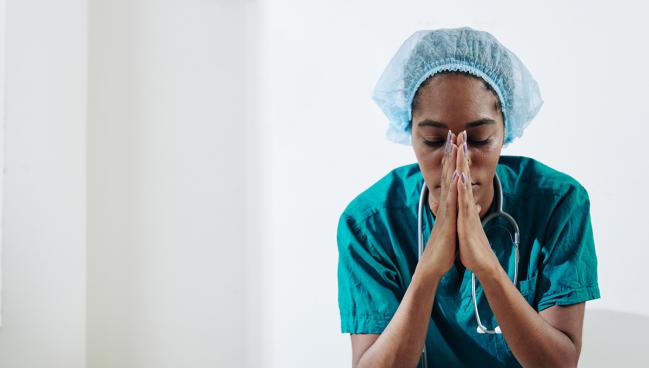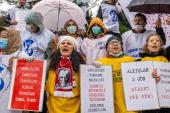As Violent Attacks on Healthcare Workers Rise, Cardiology Takes Note
Physical assaults by patients and relatives are becoming more common in cardiology. What can be done to keep safe?

When a patient returned to the heart failure (HF) practice of Giuseppe Galati, MD (Milan, Italy), after an absence of several years, Galati learned that he’d stopped taking his prescriptions but had “toured” several other hospitals, where he’d had a range of invasive procedures including implantation of a CRT-D device. Galati restarted the patient on the four guideline-recommended HF therapies and within a month was able to show the patient how much he’d improved.
To his surprise, the patient, whose many procedures had not yielded the same gains, was furious.
“He became unexpectedly very argumentative,” Galati said. “He started shouting and pushing and insulting me. I advised the directors of my hospital, in order to avoid another episode of aggression like the previous one, but they did not do anything and one and a half months later, again the hospital sent me this patient. Luckily, one of my colleagues decided to substitute for me.”
While this altercation was not particularly serious, Galati has heard other stories, including that of a female, second-year cardiology resident who last October was physically assaulted by a patient’s son after the patient called to say he was “dying” of neglect on the cardiology ward.
Tales like these, and worse, are heard in hospital corridors, shared on social media, and—increasingly—make newspaper headlines around the world. Violent attacks by patients and family members on healthcare workers in frontline care, emergency rooms, and psychiatric wards have become all-too common. What’s unclear is how much this dangerous behavior is spreading to other healthcare settings, including cardiac wards and clinics.
The Rising Problem of Hospital Violence
World Health Organization data suggest that nearly 40% of healthcare professionals experience physical violence at work. Even prior to the COVID-19 pandemic, those numbers were rising. According to the US Bureau of Labor Statistics, rates of “intentional injury caused by another person” rose by 67% between 2011 and 2018 among healthcare professionals. Regional and country-level studies have, to varying degrees, painted a similar picture: psychiatric and emergent care settings bear an outsized burden of physical aggression, while nurses and allied health professionals, especially women, are targeted more than doctors.
What’s also clear is that attacks and harassment only increased during the pandemic, with numerous, typically survey-based studies documenting a rise in bullying and aggression towards healthcare workers, including a cross-sectional global study published in the BMJ in late 2020 and a cardiology-led survey of health professionals in 19 countries across Latin America published in Current Problems in Cardiology in October 2022. This latter study found that more than one in ten survey respondents had experienced some form of physical abuse and over half had been verbally abused.
My kids have had active shooters scenarios and drills within their schools; I had my first one this week and I've been in healthcare for 20 years. Andrea Price
Cardiologist Sebastián Garcia-Zamora, MD (Delta Clinic, Rosario, Santa Fe, Argentina), was the lead author of the 19-nation snapshot. Speaking with TCTMD, he said that even with these numbers in hand, they don’t tell the whole story.
“In our survey, we saw that most of the healthcare providers do not make any kind of report of the abuse,” he said. Nurses, who were significantly more likely than physicians to experience attacks were even less likely to report the incidents. “Our hypothesis, although we cannot be sure, is that in some way this has become naturalized. People are thinking, this is just part of the job.”
Gerald E. Harmon, MD, immediate past president of the American Medical Association and the vice president of medical affairs at Tidelands Health in coastal South Carolina, believes physical harassment of health professionals has been on the rise for at least the last decade. Just the other night, he told TCTMD, an emotionally unstable patient being triaged in the emergency room at his hospital grew agitated, ultimately digging into the sharps container and using the needles and blades to attack the staff who came to examine her.
“Violence, anecdotally, is occurring in my neighborhood in small town America,” Harmon said. “I talked to my chief of security here and he says, ‘Dr. Harmon, we're having maybe about eight of these events a month where we're having a call outside law enforcement to one of our two hospital rooms.’ . . . We’re definitely seeing an uptick.”
Cardiology Impact
Ask around about whether violent attacks are rising in cardiovascular medicine, too, and everyone will mention Michael Davidson. Davidson was the 44-year-old cardiothoracic surgeon tragically shot and killed in the cardiovascular center at Boston's Brigham and Women's Hospital in 2015 by Stephen Pasceri, the son of a Davidson’s former patient. Pasceri fired five shots at close range before turning the gun on himself.
Others mention the cardiologist killed in Turkey last year by another angry relative, prompting a countrywide walkout by healthcare professionals demanding better protections.
Most, however, say that cardiology wards and private practices have been relatively immune to the kinds of verbal and physical assaults affecting their colleagues, although there is a strong sense that something has shifted, making the workplace less safe, more volatile.
When it comes down to not trusting the healthcare workers, that's a pretty low bar. Gerald E. Harmon
Certainly, the COVID-19 pandemic—the stress and anxiety fostered by its many unknowns as well as the misinformation that filled those gaps—added fuel to an already smoldering fire, emboldening patients to challenge and in some cases lash out at their healthcare providers.
“We're in a pandemic of mistrust and disinformation,” Harmon observed. “We've lost trust in our institutions, in our public health officials, in our government, and in the folks that are supposed to be entrusted with the infrastructure of civilization. And when it comes down to not trusting the healthcare workers, that's a pretty low bar. . . . historically, we’ve always trusted our doctors.”
That erosion of trust inevitably works both ways. Cardiovascular nurse, Andrea Price, MS, RCIS, of the American College of Cardiology Cardiovascular Team Council, says she isn’t aware of any specific data documenting a rise in physical attacks against cardiovascular disease specialists across the board, but she said there are “certainly more conversations occurring” and, perhaps, more defensive measures being put in place.
For roughly 15 years, she said, “my kids have had active shooters scenarios and drills within their schools; I had my first one this week and I've been in healthcare for 20 years.”
Beyond COVID-19
Pamela Douglas, MD (Duke Clinical Research Institute, Durham, NC), says she hasn’t experienced an increase in physical aggression herself, but has noticed new signs reminding everyone to “behave properly” that have been posted throughout her hospital.
“I have to assume that there is a reason for these signs, that a response like it is because this is more of an issue,” she told TCTMD. “It would be logical to assume if people are rude and violent on airplanes, and in traffic, and all those other places where people misbehave, that they're going to do that in healthcare settings, which are very stressful environments. There's a lot of uncertainty, a lot of bad news, a lot of loss of control: it's an ideal setting for somebody to lash out because they just don't feel like they can handle the situation or have agency in that situation.”
This is not like eating at a starred Michelin restaurant where you can say the first dish was very good, the second not so good. A hospital is different. Giuseppe Galati
Galati believes rising aggression among patients is part of a larger pattern of cultural entitlement. Over the last 25 to 30 years, he said, patients have started to treat physicians and nurses the same way they would waiters in restaurants. Not only are healthcare professionals judged by internet-based ratings, but patients are increasingly questioning the quality of the “service” from their personal perspective.
“This is not like eating at a starred Michelin restaurant where you can say the first dish was very good, the second not so good. A hospital is different, and when you go there you should respect the people that work there because they are solving not only your problem, but also the important health problems of other people,” he explained. “How can you complain about a delay when the reason is that your doctor was helping someone who was dying? This is not like having your hair cut or wanting to fill your belly or dress well. This is a health problem, a major issue in people's lives.”
Hany Ragy, MD (National Heart Institute, Cairo, Egypt), pointed out that the reasons for patient aggression will differ by country and region. Nearly 4 years ago, outraged family members stormed into his cath lab in Cairo following the death of a loved one, destroying the equipment with sticks and bats, although physicians and staff were unharmed.
In his part of the world, he said, economic insecurity, poverty, as well as the powerlessness that comes with misunderstanding the risks and benefits of a given procedure are what typically underpin the violence he’s seen in his hospital. A lack of true informed consent, he said, can lead to unrealistic expectations that morph quickly to anger when procedures are unsuccessful in saving a life.
“I don't want to upset other doctors, but I'm actually extremely sympathetic, in my own way, to grieving, violent, families,” because they many times do not have the education or resources to make sense of the tragedy. In these instances, he said, “I try to understand them because I think if we understand the mechanism by which this reaction occurs, we might be able to avoid it.”
Douglas, too, mentioned the share of responsibility borne by physicians: “It's the doctor's job to educate patients. If a patient doesn't have the information that they need to make an intelligent contribution to the decision or make an intelligent decision, period, then I think it's the physician’s job to help them to understand the situation if that's the issue.”
Preparedness and Training
Everyone who spoke with TCTMD stressed the need for better preparedness and skills to meet what to some feels like a rising tide.
Such training, said Douglas, should be tailored to the unique needs of each institution or setting. “Handling an angry patient is an important skill and it's not innate,” she said. “I think it is a learned skill and there are right and wrongs in how to do it, and I do think that's something that anybody dealing with patients needs to know.”
Handling an angry patient is an important skill and it's not innate. Pamela Douglas
Harmon noted that the AMA has been working on resources for physicians and other healthcare professionals to learn tools for deescalating patient or family member anxiety or frustration before it spirals into violence. Simple things, too, can make a difference—removing sharps containers to safer, less accessible locations, for example.
Douglas, likewise, referenced a growing movement to leaving doors open to deter the day-to-day harassment disproportionately faced by women, junior staff, and minorities. “As a female cardiologist or as a female nurse, you are alone in a room with the door closed with people who are often not fully dressed, and that is not generally a safe situation,” she said. “I have friends who been harassed in major ways, or grabbed, because the door is closed.” An imperfect solution, then, is “you pull the curtain, but leave the door open, so that if you need to call for help you can,” she suggested.
Ragy, noting that he has been a practicing cardiologist for over 40 years, says he now knows instinctively if a patient or relative might turn violent.
“You can almost smell the danger,” he said, saying that he’s learned how to diffuse a situation, or when to call for help. “I think doctors should be taught in medical school how to avoid violence,” he said. “By training, I'm super sympathetic to those people. Of course, violence should never be tolerated, but if there's any way to abort it before it happens, I think we should study and teach all those ways.”
Better Legislation, Better Security
Many, like Galati in Italy and Garcia-Zamora in Argentina, stressed the need for specific legislation protecting healthcare workers from patients. Tougher sentences for people who assault healthcare professionals would be a key deterrent, Galati said, making violent behavior more taboo and giving healthcare professionals some incentive to speak up and report incidents to their superiors.
Harmon noted that the AMA, in partnership with the American Academy of Pediatrics and the Children’s Hospital Association sent a letter to US Attorney General Merrick Garland urging the Department of Justice to investigate the increasing threats of violence against physicians and hospitals and families of children, a move prompted by incidents relating to providers and facilities attacked for providing and seeking gender-affirming care.
After 3 years of COVID-19, healthcare workers are still in the midst of a “pandemic of burnout,” with AMA data estimating that one in five doctors and two in five nurses are planning to retire or switch professions in the next 24 months. “We need to look at healthcare workers as, I wouldn't say an endangered species, but a somewhat protected species, because certainly we have a looming and worsening healthcare workers' shortage,” Harmon said. “So when they are physically threatened with violence, then I think we need to hold that perpetrator accountable to perhaps a higher standard.”
Many hospitals around the world are ramping up security. According to a Brigham and Women’s spokesperson, in the 8 years since Davidson’s murder, the hospital has created an in-house team of police and security officers who work hand-in-hand with the Boston Police Department; improved emergency alert systems; upgraded security technology; and implemented a number of new policies, procedures, and employee trainings focused on preventing, deescalating, and managing crisis events.
But this is by no means the standard around the world. In Italy, said Galati, back in the 1980s and ‘90s, both public and private hospitals used to have police on site, but as federal funding for those positions decreased, institutions have had to hire private security companies to do the job—something not all hospitals can afford around the clock.
Indeed, rising attacks on Italian healthcare workers—and specifically an incident where a colleague was punched—spurred Manuel Ruggiero, MD (Ospedale Santa Maria delle Grazie di Pozzuoli, Naples), to found the organization Nessuno Tocchi Ippocrate (Hands Off Hippocrates) “to protect healthcare personnel from the aggressions we suffer on a daily basis,” Ruggiero told TCTMD in an email.
The organization is asking the government to strengthen security measures at hospitals and extend to healthcare workers the protected status enjoyed by public officials, by law, which would allow aggressors to be prosecuted.
Changing Relationship With Patients
Inevitably, stories of physical and verbal abuse are transforming the relationship between patients and the people providing their care. In late 2022, for example, the Mass General Brigham healthcare system unveiled its Patient Code of Conduct, which applies to all patients at Brigham and Women’s Hospital and other Mass General Brigham hospitals.
Douglas referenced the Patient Bill of Rights, first introduced in the 1970s and revised in the 1990s to govern patients expectations for care and communication. Patients’ rights, however, now needed to be viewed alongside of those of the people providing that care.
“When I went to medical school the thinking was, traditionally, that the patient is always right, and you had to do everything and anything you can to make the patient happy,” she said. “But the reality is that sometimes you can't help everyone and then the reaction from the patient is out of bounds, or from the family is out of bounds. As a result, physicians and even more often nurses and allied health professionals end up having to bear the brunt of some pretty bad behavior that really shouldn't happen.”
Sometimes that means the hospital’s duty to protect their workers may be at odds with the patients’ requests. “We’re realizing that patients actually can be asked to leave if they are not behaving properly, and families can be asked to leave,” said Douglas. “And that’s a big change.”
Price agreed. “My perception, having been working in healthcare for 20 years, is that you must always try to take care of the patient and you can't turn patients away. So what do you do when a patient is aggressive or a family member is aggressive? That puts us into a much different culture than what we have been in for quite a number of years.”
Price is still processing some of the lessons she learned during the active shooter drill at her hospital. The former police officer who conducted the training used the analogy of passengers in an airline crash taking the time to retrieve their carry-on luggage when instead they needed to be hustling out of the plane. The same scenario applies, to some degree, to an active shooter.
“One thing that he shared was: whenever you can leave, you need to leave,” said Price. “You need to leave everything there and just get yourself out, which goes against a lot of what healthcare professionals have been trained to do.”
Shelley Wood is the Editor-in-Chief of TCTMD and the Editorial Director at CRF. She did her undergraduate degree at McGill…
Read Full Bio



Comments